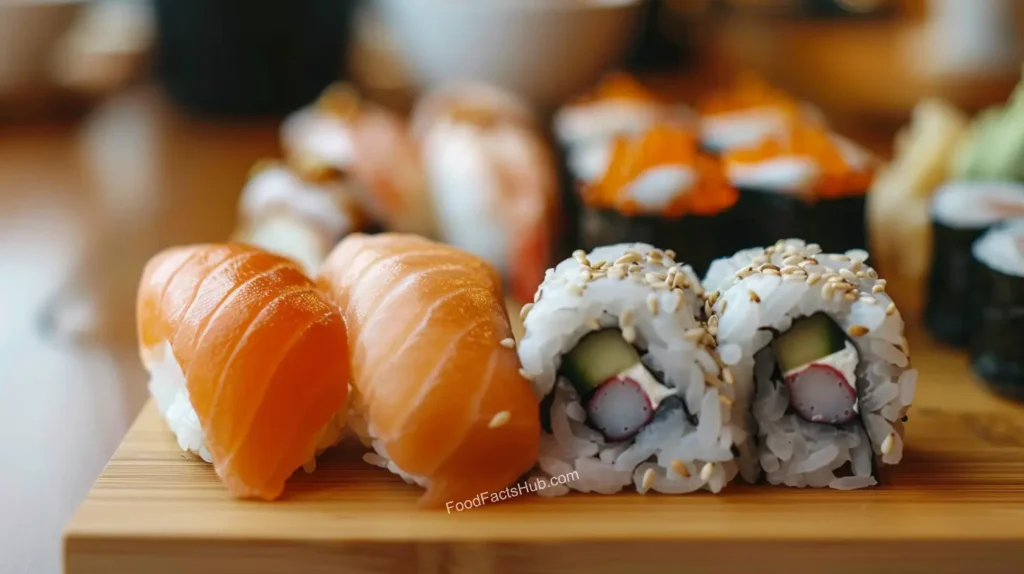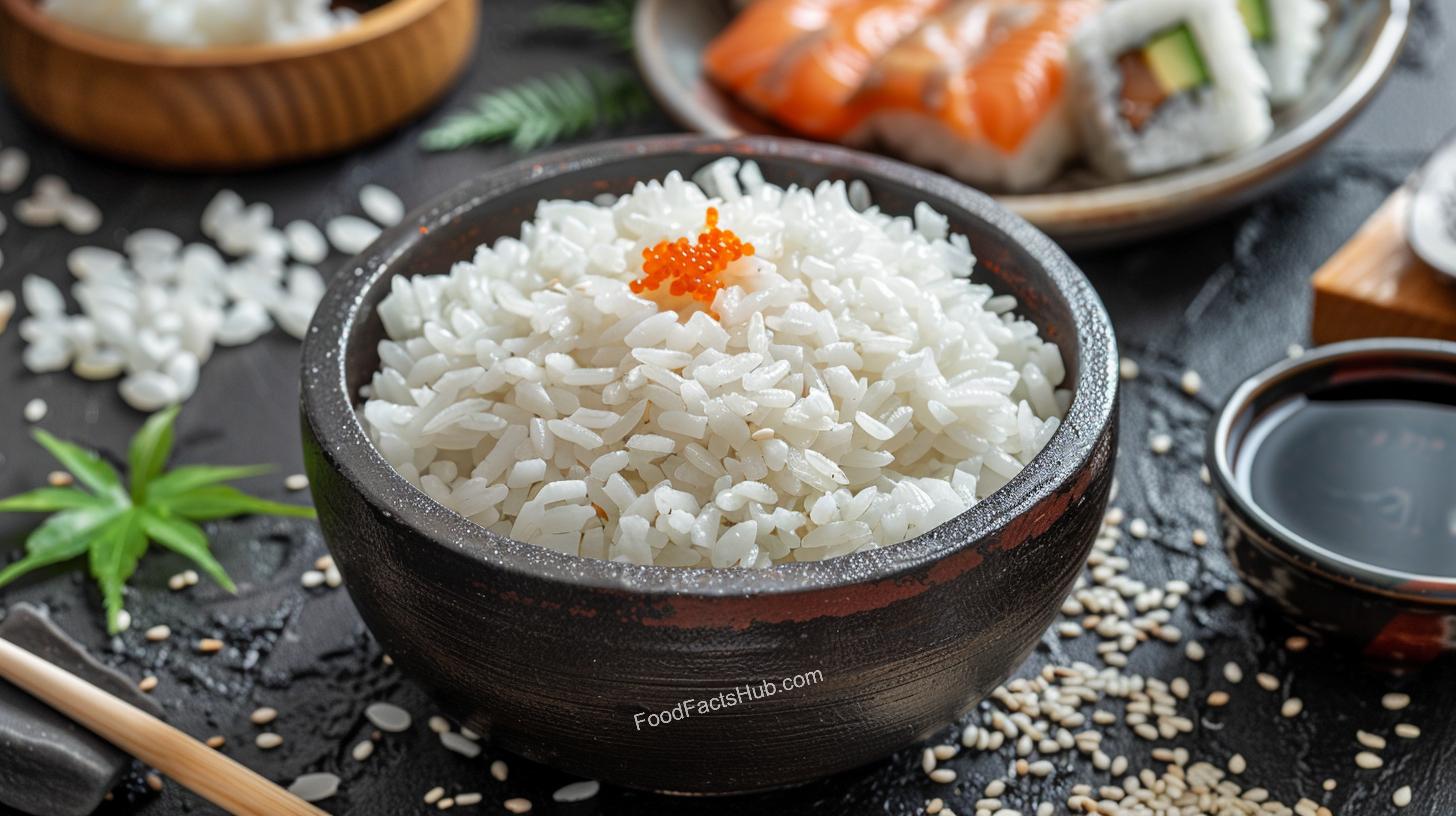The pictures in our articles might not always show exactly what the text is talking about. We use these images to make the article more interesting and eye-catching. They are there to add to the text, but not to replace it or show every detail.
Introduction
Sushi lovers and health enthusiasts, gather 'round! Today, we're diving deep into the world of sushi rice nutrition facts. This humble grain, the foundation of your favorite Japanese delicacy, is more than just a sticky base for raw fish. It's a nutritional powerhouse that brings a host of health benefits to your plate.
In this comprehensive guide, we'll uncover 18 fascinating facts about sushi rice nutrition that will make you appreciate your next sushi roll even more. From its energy-boosting properties to its surprising versatility, we'll explore every grain of goodness that sushi rice has to offer. So, grab your chopsticks and let's roll into the delicious world of sushi rice!
Key Takeaways
Before we dive into the details, here are some key points to remember about sushi rice nutrition facts:
- Sushi rice is a low-fat, gluten-free carbohydrate source that provides quick energy.
- It contains essential vitamins and minerals, including B-complex vitamins and iron.
- The sticky texture of sushi rice promotes feelings of fullness, aiding in portion control.
- Sushi rice is versatile and can be used in various dishes beyond traditional sushi.
- When prepared traditionally, sushi rice contains added vinegar, which may offer additional health benefits.
The Nutritional Profile of Sushi Rice

1. Caloric Content: Fuel for Your Day
Let's start with the basics of sushi rice nutrition facts. A standard serving of sushi rice (100 grams) contains approximately 130 calories. This makes it a moderate-calorie food that can fit into most balanced diets. The calories in sushi rice primarily come from its carbohydrate content, providing you with a quick source of energy.
2. Carbohydrates: The Energy Powerhouse
Sushi rice is predominantly composed of carbohydrates. In fact, about 90% of its calorie content comes from carbs. A 100-gram serving provides roughly 28 grams of carbohydrates. These carbs are essential for:
- Providing immediate energy for your body and brain
- Fueling your muscles during physical activities
- Supporting digestive health through dietary fiber
3. Dietary Fiber: A Digestive Friend
While not as high in fiber as brown rice, sushi rice still contains a moderate amount of dietary fiber. A 100-gram serving provides about 0.3 grams of fiber. This may seem small, but it contributes to your daily fiber intake, which is crucial for:
- Promoting regular bowel movements
- Supporting gut health
- Helping you feel full and satisfied after meals
4. Protein Content: Small but Significant
Sushi rice nutrition facts reveal that it's not a significant source of protein. A 100-gram serving contains about 2.4 grams of protein. However, when combined with other sushi ingredients like fish or tofu, your sushi meal becomes a more complete protein source.
5. Fat Content: Keeping It Lean
One of the most appealing aspects of sushi rice nutrition is its low fat content. A 100-gram serving contains less than 0.3 grams of fat, making it an excellent choice for those watching their fat intake.
Vitamins and Minerals in Sushi Rice
6. B-Complex Vitamins: The Energy Boosters
Sushi rice is a good source of B-complex vitamins, particularly:
- Thiamin (B1)
- Niacin (B3)
- Vitamin B6
These vitamins play crucial roles in energy metabolism, nerve function, and the formation of red blood cells.
7. Iron: The Oxygen Carrier
Sushi rice nutrition facts show that it contains a small amount of iron. While not as high as in some other foods, every bit counts towards meeting your daily iron needs. Iron is essential for:
- Carrying oxygen throughout your body
- Supporting a healthy immune system
- Preventing iron-deficiency anemia
8. Magnesium: The Multitasker
Sushi rice contains magnesium, a mineral involved in over 300 enzymatic reactions in your body. Magnesium contributes to:
- Muscle and nerve function
- Energy production
- Bone health
- Blood glucose control
9. Phosphorus: Building Strong Bones
Another mineral found in sushi rice is phosphorus. This mineral works alongside calcium to build and maintain strong bones and teeth.
Health Benefits of Sushi Rice
10. Quick Energy Source
The high carbohydrate content of sushi rice makes it an excellent source of quick energy. This can be particularly beneficial:
- Before or after workouts
- During busy workdays when you need a mental boost
- For athletes needing to replenish glycogen stores
11. Gluten-Free Goodness
For those with celiac disease or gluten sensitivity, sushi rice nutrition facts bring good news. Sushi rice is naturally gluten-free, making it a safe and delicious option for those avoiding gluten.
12. Low in Fat and Cholesterol
The low fat content of sushi rice makes it heart-healthy. It's particularly beneficial for those:
- Watching their cholesterol levels
- Following a low-fat diet
- Looking to maintain a healthy weight
13. Potential Blood Sugar Benefits
The vinegar used in preparing sushi rice may have beneficial effects on blood sugar levels. Some studies suggest that vinegar can help:
- Improve insulin sensitivity
- Reduce blood sugar spikes after meals
However, more research is needed to fully understand these effects.
The Versatility of Sushi Rice
14. Beyond Sushi: Creative Culinary Uses
While we love sushi rice in our favorite rolls, its uses extend far beyond traditional Japanese cuisine. Here are some creative ways to use sushi rice:
- As a base for poke bowls
- In rice salads
- As a side dish for stir-fries
- In desserts like rice pudding
15. Hot or Cold: Temperature Flexibility
Sushi rice nutrition facts remain consistent whether the rice is served hot or cold. This temperature flexibility makes it a versatile ingredient for various dishes and seasons.
Sushi Rice Preparation and Its Impact on Nutrition
16. The Vinegar Factor
Traditional sushi rice is prepared with a mixture of rice vinegar, sugar, and salt. This preparation method:
- Adds a subtle tangy flavor
- Helps preserve the rice
- May offer additional health benefits due to the vinegar content
17. Sodium Considerations
The addition of salt in the vinegar mixture increases the sodium content of sushi rice. While not excessively high, those on sodium-restricted diets should be mindful of this.
18. Portion Control Made Easy
The sticky texture of sushi rice makes it easy to form into compact portions. This can be beneficial for:
- Controlling serving sizes
- Creating visually appealing dishes
- Feeling satisfied with smaller amounts
Sushi Rice vs. Other Rice Varieties
To better understand sushi rice nutrition facts, let's compare it to other common rice varieties:
| Rice Type | Calories (per 100g) | Carbs (g) | Protein (g) | Fiber (g) |
|---|---|---|---|---|
| Sushi Rice | 130 | 28 | 2.4 | 0.3 |
| Brown Rice | 111 | 23 | 2.6 | 1.8 |
| White Rice | 130 | 28 | 2.7 | 0.4 |
| Wild Rice | 101 | 21 | 4.0 | 1.8 |
As we can see, sushi rice is comparable to white rice in terms of calories and macronutrients. However, it has slightly less fiber than brown or wild rice.
The Role of Sushi Rice in a Balanced Diet
This graph illustrates how sushi rice contributes to various aspects of a balanced diet, particularly in the carbohydrate and micronutrient categories.
FAQs About Sushi Rice Nutrition
Is sushi rice healthier than regular white rice?
Sushi rice and regular white rice have similar nutritional profiles. However, the vinegar added to sushi rice may offer additional health benefits, such as improved blood sugar control.
Can sushi rice be part of a weight loss diet?
Yes, sushi rice can be part of a weight loss diet when consumed in moderation. Its sticky texture can help with portion control, and it's low in fat.
Is sushi rice safe for people with diabetes?
While sushi rice is high in carbohydrates, it can be included in a diabetic diet with proper portion control. The vinegar used in its preparation may also help with blood sugar management.
How does sushi rice compare to brown rice nutritionally?
Brown rice contains more fiber and slightly more vitamins and minerals than sushi rice. However, sushi rice is easier to digest and provides quicker energy.
Can I make sushi rice healthier?
You can boost the nutritional value of sushi rice by mixing it with other grains or adding vegetables to your sushi rolls.
Conclusion
As we've discovered through these 18 sushi rice nutrition facts, this humble grain is more than just a vehicle for your favorite sushi toppings. It's a versatile, energy-providing carbohydrate that offers several health benefits when consumed as part of a balanced diet.
From its role as a quick energy source to its potential benefits for blood sugar control, sushi rice proves that sometimes, the simplest foods can be nutritional powerhouses. So the next time you sit down to enjoy your favorite sushi roll, you can appreciate not just its delicious taste, but also the nutritional boost it's giving your body.






